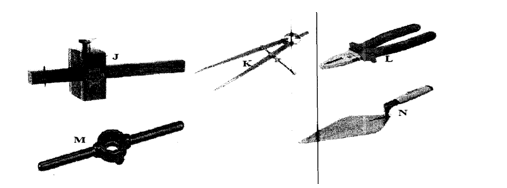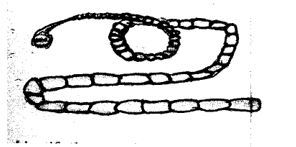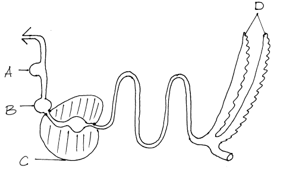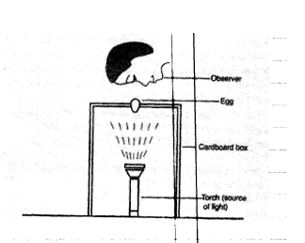INSTRUCTIONS
- This paper consists of three sections A, B and C.
- Answer all questions in section A and B and any other two questions in section C.
- Candidate must answer the questions in English.

QUESTIONS
SECTION A: 30 MARKS
Answer ALL questions in this section in the spaces provided
- State four features of a good pig house (2marks)
- State four features of large white breed of pigs (2marks)
- Name three stages of liver fluke which occurs in the fresh water snail (1½marks)
- State four reasons for controlling livestock diseases (2marks)
- Name four factors which determine the maintenance requirements of an animal (2marks)
- Give four ways of stimulating milk let down in a dairy cow (2marks)
- Distinguish between the following pair of terms as used in livestock production
- Ringing and crutching (1mark)
- Steaming up and flushing (1mark)
- Give four reasons for maintaining a wheel barrow in good working condition (2marks)
- State four symptoms of Newcastle disease in poultry (2marks)
- State four disadvantages of a tractor as a source of power (2marks)
- Give four conditions that reduces the quality of eggs for hatching (2marks)
- Name three methods that are used in selection of breeding stock in livestock production (1½marks)
- State four construction features necessary in a fish pond (2mark)
- Give an appropriate terms that refers to each of the following
- Castrated chicken (½mark)
- Young one of a rabbit (½mark)
- State four methods of dehorning (2marks)
- State four disadvantages of in breeding (2marks)
SECTION B: 20 MARKS
Answer ALL questions in the spaces provided
- The diagram below represents farm tools and equipment. Study them and answer the questions that follow

- Identify the tools and equipment J and K (2marks)
J……………………………………………………………………………………………………………
K…………………………………………………………………………………………………………….. - State the uses of tools labelled L, M and N (3marks)
L…………………………………………………………………………………………………………
M…………………………………………………………………………………………………………
N……………………………………………………………………………………………………………
- Identify the tools and equipment J and K (2marks)
- The diagram below shows a livestock parasite

- Identify the parasite (1mark)
- Explain how the parasite can be passed from;
- Livestock to human beings (1mark)
- Human beings to animals (1mark)
- State two control measures for the parasite in a zero grazing unit (2marks)
- Study the diagram below and answer the questions that follow

- Identify the parts labelled (2marks)
B
D - State the function of part labelled A (1mark)
- State two adaptations of parts labelled C to its function (2marks)
- Identify the parts labelled (2marks)
- Below is an illustration of an activity carried out by a poultry farmer keeping layers

- Give one reason for carrying out the practice in poultry layering (1mark)
- State two faults which can be detected using the method illustrated above (2marks)
- How can a farmer improve the following in poultry production
- Hardness of egg shell (1mark)
- Yellowness of egg York (1mark)
SECTION C: 40 MARKS
Answer any TWO questions from this section in the spaces provided after question 23
-
- Describe Ten causes of low egg production in layers (10marks)
- Discuss foot and mouth disease under the following headings:
- Causal organism (1mark)
- Livestock species attacked (2marks)
- Symptoms of attack (4marks)
- Control measures (3marks)
-
- Outline five advantages of artificial insemination in cattle management (5marks)
- Explain five factors that a farmer should consider when sitting a bee hive to prevent swarming (5marks)
- Explain five precautions taken by dairy farmer to ensure clean milk production (10marks)
-
- State five characteristics of light breed of poultry (5marks)
- Describe the operation of a four stroke cycle engine (12marks)
- State three good hygiene practices in livestock feeding (3marks)

MARKING SCHEME
SECTION A: 30 MARKS
Answer ALL questions in this section in the spaces provided
- State four features of a good pig house (2marks)
- Should be leak-proof/rainproof
- Should be well ventilated
- Should be easy to clean
- Should be well lit
- Should be draught free
- Should have adequate space
- Should have good drainage
- State four features of large white breed of pigs (2marks)
- A long body
- White with blue body spots
- Broad and slightly dished snout
- Upright ears
- Name three stages of liver fluke which occurs in the fresh water snail (1½marks)
- Sporocysts
- Redia
- Cercaria
- State four reasons for controlling livestock diseases (2marks)
- Reduce spread of livestock diseases
- Promote fast growth
- Promote early maturity
- Increase their productive life
- Improve quality of products
- Improve quantity of products
- Reduce cost of production
- Name four factors which determine the maintenance requirements of an animal (2marks)
- Weather conditions
- Age of the animal
- Level of activity
- Body size of the animal
- Physiological condition
- Give four ways of stimulating milk let down in a dairy cow (2marks)
- Washing the udder with warm water
- Allow the calf to suck for a while/ presence of a calf
- Feeding the cow during milking
- Regular milking time
- Sound associated with milking
- Massaging the udder when washing it
- Distinguish between the following pair of terms as used in livestock production
- Ringing and crutching (1mark)
- Ringing is cutting short wool from around the perite sheath of a ram for easy mating.
Crutching is cutting of wool from the around the ewe’s external reproductive organ for easy mating
- Ringing is cutting short wool from around the perite sheath of a ram for easy mating.
- Steaming up and flushing (1mark)
- Steaming up – provision of feeds of high nutritive value to pregnant animals a few weeks before parturition
Flushing – providing female sheep with extra feed of high nutritive value 3 weeks before and after mating
- Steaming up – provision of feeds of high nutritive value to pregnant animals a few weeks before parturition
- Ringing and crutching (1mark)
- Give four reasons for maintaining a wheel barrow in good working condition (2marks)
- To reduce cost of replacement
- To improve efficiency
- To prolong life of the wheelbarrow/ for durability
- To prevent injury to the user
- To prevent damage to the wheel barrow
- State four symptoms of Newcastle disease in poultry (2marks)
- Difficulties in breathing
- Coughing and sneezing
- Head and neck twisted backwards
- Decreased egg production
- Drooping wings
- Walking in a staggering manner
- Profuse nasal discharge
- High mortality rate
- Dullness
- Loss of appetite
- Greenish diarrhoea
- Eggs laid have soft shells
- Birds stand with eyes closed all the time
- Beaks remain wide open and neck strained
- State four disadvantages of a tractor as a source of power (2marks)
- Expensive to buy
- Require skilled personnel
- Their use is limited in certain areas e.g. sloppy areas
- It requires support services
- Expensive to maintain
- Give four conditions that reduces the quality of eggs for hatching (2marks)
- Dirt
- Abnormal size – undersize/ lower size
- Broken/ soft shell
- Internal abnormalities / poor candling qualities
- Poor storage/ long storage beyond 10 days
- Abnormal shape
- Name three methods that are used in selection of breeding stock in livestock production (1½marks)
- Progeny testing
- Mass selection
- Contemporary comparison
- State four construction features necessary in a fish pond (2mark)
- Outlet pipe to drain out water
- Inlet pipe to allow in fresh water
- Spillway to allow overflow of excess water
- Screen to prevent escape of fish or entry of predators in the pond
- Fence to keep off predators
- Give an appropriate terms that refers to each of the following
- Castrated chicken (½mark)
- Capon
- Young one of a rabbit (½mark)
- Kindle/kindling
- Castrated chicken (½mark)
- State four methods of dehorning (2marks)
- Use of caustic potash stick
- Use of dehorning iron
- Use of rubbering and elastrator
- Use of dehorning wire/saw
- Use of dehorning collodion
- State four disadvantages of in breeding (2marks)
- Leads to loss of hybrid vigour
- Leads to decline in fertility leading to species extinction
- Bring about decrease in performance
- Leads to high rate of prenatal mortality
SECTION B: 20 MARKS
Answer ALL questions in the spaces provided
- The diagram below represents farm tools and equipment. Study them and answer the questions that follow
- Identify the tools and equipment J and K (2marks)
- J – Marking gauge
- K – Divider
- State the uses of tools labelled L, M and N (3marks)
- L – Cutting and splicing wires
- tightening and loosens nuts and bolts - M – Making threads on metallic pipers
- N – Placing mortar between construction stones and bricks
- L – Cutting and splicing wires
- Identify the tools and equipment J and K (2marks)
- The diagram below shows a livestock parasite
- Identify the parasite (1mark)
- Beef/ pork tapeworm / taenia spp
- Explain how the parasite can be passed from;
- Livestock to human beings (1mark)
- Ingestion of bladder worm
- Ingestion of under cooked/ uncooked infected meat
- Human beings to animals (1mark)
- Ingestion of eggs / proglottids passed in human faeces during grazing / feeding
- Livestock to human beings (1mark)
- State two control measures for the parasite in a zero grazing unit (2marks)
- Regular deworming of the animals
- Observing hygiene to avoid contamination
- Identify the parasite (1mark)
- Study the diagram below and answer the questions that follow
- Identify the parts labelled (2marks)
- B Proventriculus/ true stomach
- D Caeca
- State the function of part labelled A (1mark)
- Temporary storage of food
- Moistening of food
- State two adaptations of parts labelled C to its function (2marks)
- Has grit/sand
- Has tough muscles
- Identify the parts labelled (2marks)
- Below is an illustration of an activity carried out by a poultry farmer keeping layers
- Give one reason for carrying out the practice in poultry layering (1mark)
- To detect the abnormalities inside the egg
- State two faults which can be detected using the method illustrated above (2marks)
- Presence of meat spot inside the egg
- Presence of blood spot inside the egg
- Double yoked egg
- Hair cracks
- Very porous
- How can a farmer improve the following in poultry production
- Hardness of egg shell (1mark)
- Providing the birds with calcium
- Yellowness of egg York (1mark)
- Providing birds with green vegetables
- Hardness of egg shell (1mark)
- Give one reason for carrying out the practice in poultry layering (1mark)
SECTION C: 40 MARKS
Answer any TWO from this section in the spaces provided after question 23
-
- Describe Ten causes of low egg production in layers (10marks)
- Inadequate feeding
- Parasite infestation
- Old age
- Broodiness
- Inadequate waterers and feeders
- Inadequate laying boxes
- Presence of predators in layers house
- Sudden noise
- Sudden change of feeds
- Sudden change of weathers e.g. to cold conditions
- Disease infection
- Discuss foot and mouth disease under the following headings:
- Causal organism (1mark)
- Virus/virus types O,A,C / South African types SAT1, SAT2, SAT3 / Asian type 1
- Livestock species attacked (2marks)
- Cattle
- Pigs
- Goats
- sheep
- Symptoms of attack (4marks)
- Profuse salivation
- Blisters with a painful ground the mouth and hooves of the feet leading to lameness
- Drop in milk production in lactating cows
- Sharp rise in temperature / high fever
- Emaciation
- Complete loss of appetite
- Diarrhoea
- Control measures (3marks)
- Imposing quarantine
- Vaccination every 6 months
- Slaughter and destruction of carcass
- Burn/burry dead animals
- Causal organism (1mark)
- Describe Ten causes of low egg production in layers (10marks)
-
- Outline five advantages of artificial insemination in cattle management (5marks)
- There is economical use of semen
- Controls transmission of breeding diseases
- Sires that are unable to serve cows due to heavy weight can produce semen to serve cows
- Prevents large bulls from injuring small cows
- Reduces the expenses of keeping a male animal in the farm
- Small scale farmers who cannot afford to buy a superior bull can have the cows served at a low cost
- Semen can be stored for a long time even in the death of the bull
- Helps to control in breeding
- Makes research work easier
- Explain five factors that a farmer should consider when sitting a bee hive to prevent swarming (5marks)
- Availability of water – should be available within 3km radius to facilitate collection by bees
- Availability of flowers – should be readily available to facilitate collection of pollen and nectar by bees
- Shelter – should be protected from strong sun and wind
- Noise and other disturbances – should be free from noise and other disturbances
- Pest and disease – the place should be free from pests and diseases
- Dampness and bad odour – site should be free from dampness and bad odour
- Explain five precautions taken by dairy farmer to ensure clean milk production (10marks)
- Maintain healthy milking herd to prevent transmission of the disease agents to milk and milk man
- Clean milking cows to prevent contamination of milk with dirt
- Maintain clean milking equipment to prevent contamination of milk
- Ensure milk is filtered to remove soil impurities
- Ensure milk is cooled properly to give it a long shelf life
- Strong flavoured food should be fed to cows after milking
- Outline five advantages of artificial insemination in cattle management (5marks)
-
- State five characteristics of light breed of poultry (5marks)
- Mainly kept for egg laying
- Have low quality meat
- Cheaper to feed because of small size
- Efficient converters of food to egg
- Mature early but slow growth rate
- Are usually nervous
- Describe the operation of a four stroke cycle engine (12marks)
Induction stroke- The piston moves down the cylinder
- Inlet valves open and exhausts valves closed
- Fresh fuel air mixture enter in to cylinder
Compression stroke - The piston moves up the cylinder
- Both inlet and exhausted valves closed
- Fresh fuel –air mixture is compresses into cylinder/ combustion chamber
Power stroke - Spark is produced at spark plug
- This causes fuel – air mixture to ignite and expand resulting in pressure that forces piston down the cylinder
- Both inlet and exhaust valve closes
Exhaust stroke - The piston moves upwards
- Exhaust valve opens, inlet valves remains closed
- Exhaust gases escapes through the open exhaust valve
- State three good hygiene practices in livestock feeding (3marks)
- Feeding animal with clean feed
- Watering animal with clean water
- Using clean feeders and waterers
- Disinfecting the feeders and waterers
- State five characteristics of light breed of poultry (5marks)
Download Agriculture Paper 2 Questions and Answers - Cekana Mock Exams 2023.
Tap Here to Download for 50/-
Get on WhatsApp for 50/-
Why download?
- ✔ To read offline at any time.
- ✔ To Print at your convenience
- ✔ Share Easily with Friends / Students
